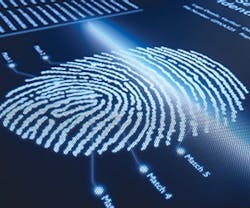Any part of the human body that is unique to an individual can be turned into a biometric credential. You may not be aware just how many forms of biometrics are available.
There are two classes of biometrics – those that are tied to the shape of physical characteristics that can be measured and behavioral traits that are based on a person’s actions. See which options would be suitable for your population.
PHYSIOLOGICAL
Fingerprint Matching
Fingerprints can be examined for external characteristics, specifically the friction ridge patterns unique to every individual. Ultrasound scanning can also capture the internal or vascular fingerprint reflected in the capillaries. A step beyond fingerprints is a palm print, which looks for variations in principle lines and other marks. The FBI recently upgraded its Integrated Automated Fingerprint Identification System (IAFIS) to include palms – over 6 million palm prints have been collected so far.
Hand Geometry
Beyond a mere finger, your entire hand offers distinctive identifiers. According to the National Science and Technology Council, hand geometry readers “use a simple concept of measuring and recording the length, width, thickness and surface area of an individual’s hand while guided on a plate.” Some scanners are able to measure the distance between the knuckles to the fingerprints, curvature of the digits and even shadow cast.
Iris Recognition
Whether you inherited your eye color from one of your parents is irrelevant – the shapes and patterns surrounding your iris are 100% original to you. Near-infrared light is used to illuminate the iris to reveal additional variations that aren’t visible in plain sight. A related but entirely separate ocular approach is retina scanning, which examines the capillaries within the eye. Both options can read the eye even if glasses or normal contacts are present.
Vein Matching
The network of veins just below the surface of your skin exhibits unique variations and can be detected with infrared light. Unlike external markers, your veins stay in the same place as you age and it would be exceedingly rare for them to become damaged. This contactless option currently has applications for time and attendance, patient identification, and logging onto computers and servers. It is even used to register for the GMAT (a business graduate school exam) to “preserve test integrity.”
Facial Recognition
This technology measures distances between specific parts of a person’s face – the sum of the various points being an exclusive attribute. An algorithm can identify the nuances between the shape and position of the eyes, nose, ears, jawline and other contours. The metrics are sophisticated enough that basic changes to a person’s appearance such as makeup, hairstyles or reading glasses do not typically interfere with a match.
Ear Identification
Were you aware that your ears are just as singular as your fingerprints? The morphology of our outer cartilage is relatively static over time and is comprised of nine separate anatomy points. Even our own ears are not a match for each other, nor are they perfect replicas among twins and other multiples. This metric is limited to forensic use at this time, but it has the potential to crossover to commercial applications once barriers such as profile angles, lighting and obfuscations with hair are resolved.
BEHAVIORAL
Gait Identification
The way humans stroll, strut and scurry provide a distinguishing sequence of motion for each individual. Radar or cameras with motion analytics look for repeating dynamics between the neck, shoulders, and limbs. Height, distance, angle and speed between all anatomical features are also measured. A key benefit is that users can be scanned from a distance without stopping.
Voice Recognition
Also referred to as speaker authentication, this system can verify a person based on patterns of speech. The combination of pitch, speed and style of speaking can all be traced to individuals. Users enroll by providing a voiceprint that serves as their credential template. To gain access, speakers will utter an agreed-upon phrase or word, which may be common to all enrolled individuals or a password specific to each person.
Handwritten Biometrics
While writing is something humans do physically, it’s based on a skill we have learned, making this a behavioral biometric. Similar to voice, individuals supply a sample of text that serves as a baseline for their writing. Depending on the system, the metrics can examine character shapes as well as speed and pressure exhibited during the act of writing. Signatures, a particular phrase, or a keyword can all be used.
Learn more about how biometrics will fortify your access control: The Case for Biometrics
About the Author
Jennie Morton
A former BUILDINGS editor, Jennie Morton is a freelance writer specializing in commercial architecture, IoT and proptech.
